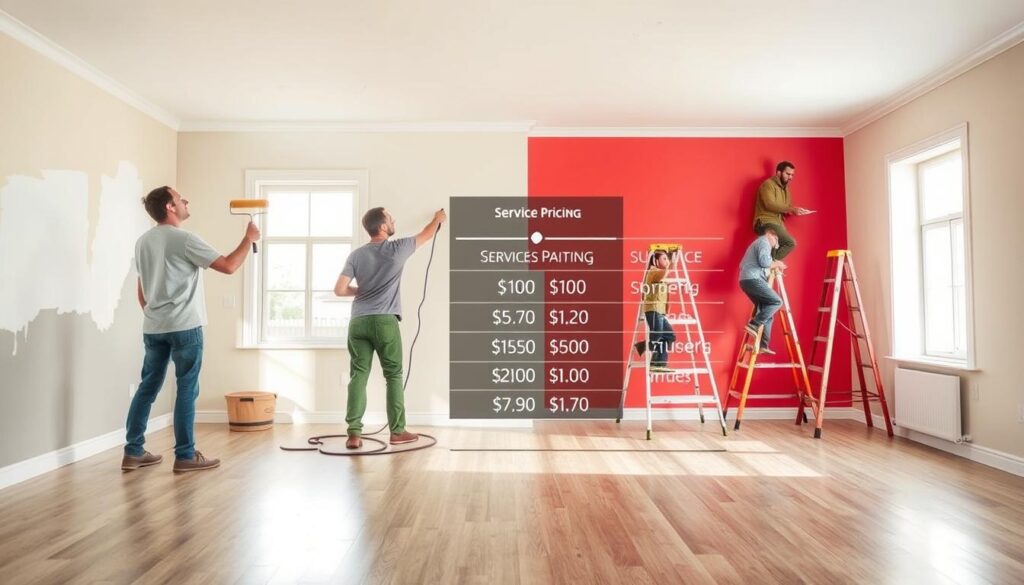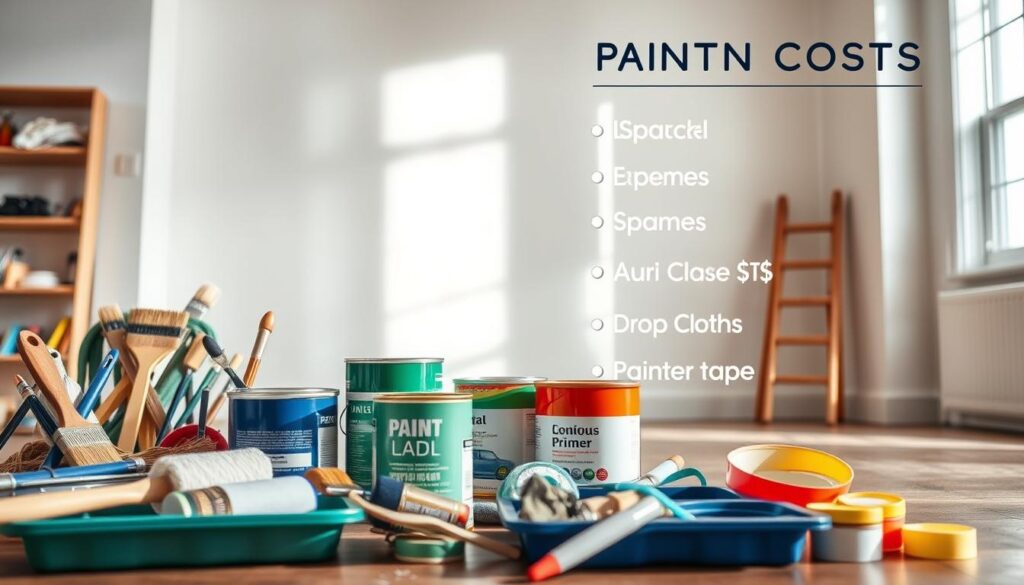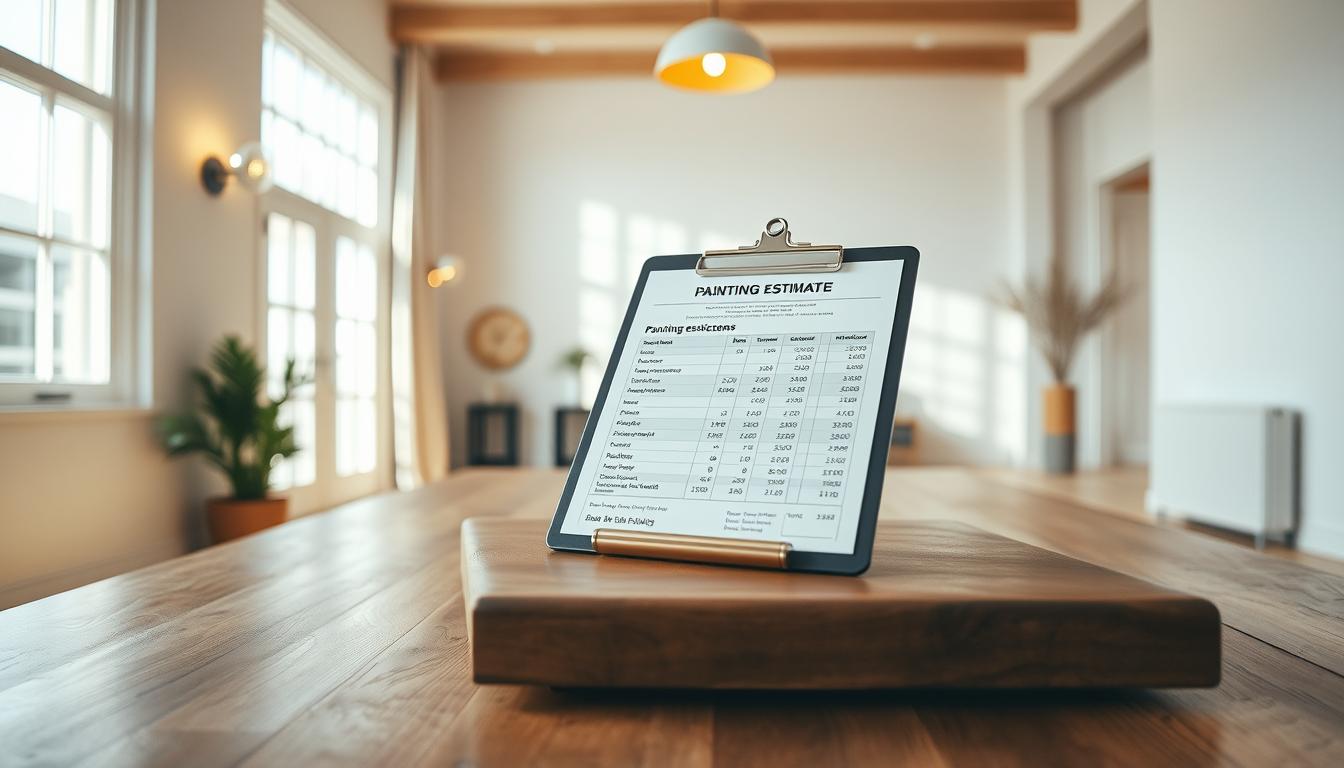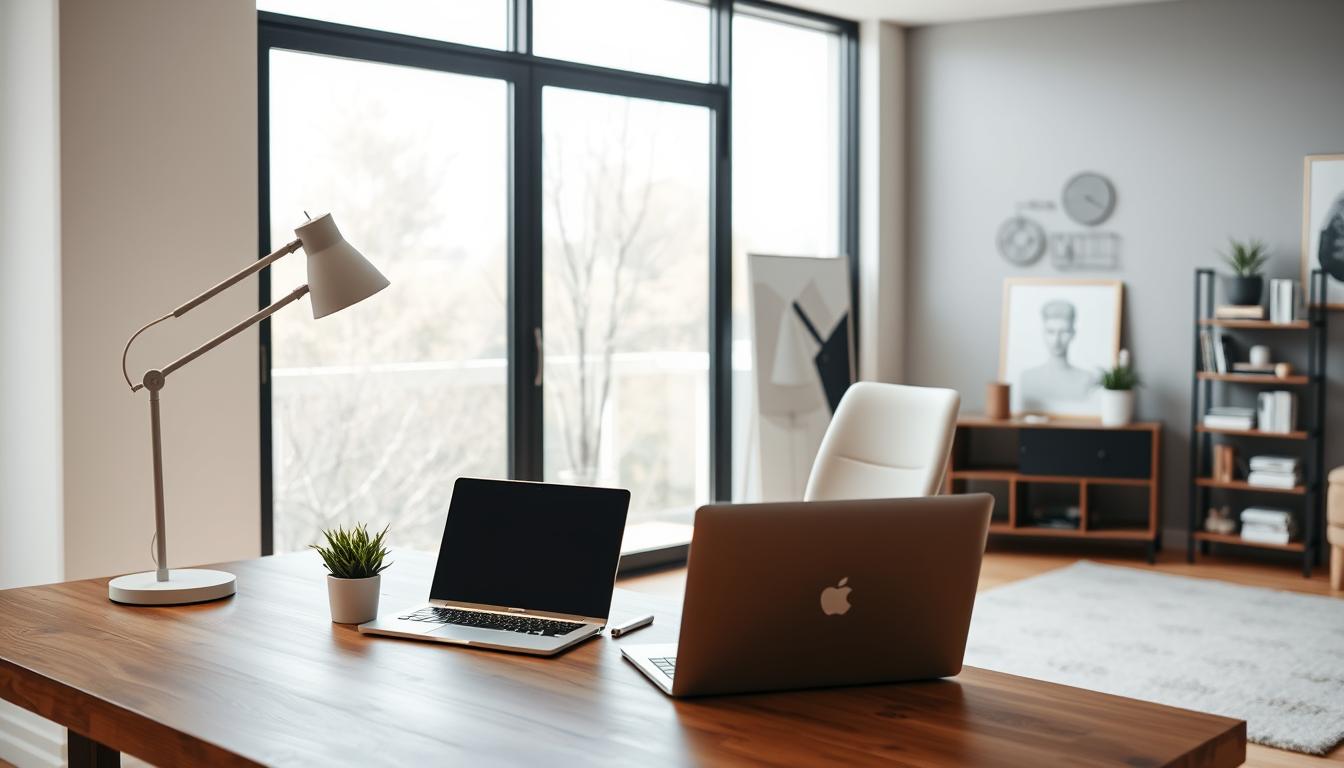Are you thinking of refreshing your home’s look? Painting the interior is a great way to do it. But, first, you need to know how much it will cost.
Angi and Home Advisor say painting the inside of a house costs between $967 and $3,076. On average, homeowners spend about $2,014. The price can change a lot based on your home’s size and the paint type.
We’ll dive into what affects the cost of painting your home’s interior. Knowing these factors helps you plan your budget better. This way, you can make smart choices.
Key Takeaways
- Average cost to paint the interior of a house: $967-$3,076
- Factors influencing the final price: size of the home, type of paint, labor costs
- Importance of getting a professional estimate for residential painting services
- Understanding the costs involved in painting the interior of your home
- Planning your budget and making informed decisions
Understanding the Factors that Influence Painting Costs
The cost to paint a home’s interior is complex. It depends on many factors. Homeowners need to think about these elements when planning to paint.
One key factor is the home’s size. The bigger the home, the more paint and work needed. This increases the cost. We’ll explore how size impacts the cost.
Size of the Home
The home’s size is crucial for painting costs. Costs are based on the square footage of walls and ceilings. This is how it’s calculated.
| Home Size (Square Feet) | Average Cost |
|---|---|
| 1,000 – 2,000 | $1,500 – $3,000 |
| 2,000 – 3,000 | $3,000 – $4,500 |
| 3,000 – 4,000 | $4,500 – $6,000 |
Larger homes cost more to paint. This is because more paint and work are needed.
Type of Paint Used
The paint type also matters a lot. Prices vary with quality, finish, and brand. For example, low-VOC paints are pricier but better for health and the environment.
“Choosing the right paint involves balancing cost, quality, and environmental considerations.”
Specialty paints, with unique finishes or textures, also raise costs. We’ll dive deeper into paint types and their cost effects later.
Labor Costs
Labor costs are a big part of painting expenses. Painters charge based on experience, location, and job complexity. Costs can differ a lot by region.
- More experienced painters might charge more but offer better quality.
- The job’s complexity, like needing extra coats or prep work, also affects costs.
Knowing these factors helps homeowners better estimate costs. This way, they can make smart choices for their painting project.
Average Cost Per Square Foot for Interior Painting
Interior painting costs are a big deal. The cost per square foot is key for planning your budget. On average, it’s $1 to $3 per square foot. But, if you include walls, ceilings, and trim, it can go up to $4.50 per square foot.
Let’s look at how these costs are figured out and what can change them.
National Averages
The national average for interior painting is about $2.50 per square foot. But, this number can change. It depends on the paint type and labor costs.
- Type of Paint: The paint’s quality and brand matter a lot. Special paints, like those with low VOC or eco-friendly options, cost more.
- Labor Costs: Labor prices differ by area and contractor. Getting pros might cost more but usually means better work.
Breakdown by Region
Costs also vary by region. Urban areas often have higher labor costs than rural ones. Here’s a look at average costs per square foot by region:
| Region | Average Cost per Square Foot |
|---|---|
| Northeast | $2.75 |
| South | $2.25 |
| Midwest | $2.50 |
| West | $3.00 |
Costs can really differ based on where you are. A room painting cost calculator can give you a closer estimate for your area.
Knowing these details and using a painting a house interior price guide helps plan your painting project. This way, you can stick to your budget.
Different Types of Interior Paint
It’s important to know the different interior paints available. This helps you choose the right one for your budget and needs. The paint type greatly affects your interior painting project’s cost.
When thinking about painting your walls, look beyond just the price. Different paints offer benefits like durability, finish, and health and environmental factors.
Standard Paint vs. Specialty Paint
Standard paint is the most used for interior projects. It’s a good mix of cost and quality, fitting most homeowners. Specialty paint, like high-gloss or metallic, adds a unique touch but costs more.
If you want a special look, like high-gloss, expect to pay more. Specialty paints need more coats or special techniques, raising labor costs.
| Type of Paint | Cost per Gallon | Characteristics |
|---|---|---|
| Standard Paint | $20-$40 | Good durability, easy to apply |
| Specialty Paint (High-Gloss) | $40-$70 | High shine, durable, but shows more imperfections |
| Low-VOC Paint | $30-$60 | Less harmful to health, eco-friendly |
Low-VOC and Eco-Friendly Options
Low-VOC and eco-friendly paints are gaining popularity. They have fewer fumes and are made from natural ingredients. This makes them safer for homes with kids or pets.
“The shift towards eco-friendly products, including paints, is not just a trend; it’s a necessity for creating healthier living spaces.” – Environmental Expert
These paints might cost more than standard ones. But they offer long-term benefits like better air quality and less environmental harm.
When figuring out the cost to paint interior walls, think about the paint’s long-term value. While initial costs matter, the paint’s durability and upkeep needs also impact your total spending.
DIY vs. Hiring Professionals: Pros and Cons
Choosing between DIY and professional painting is more than just about money. It’s about how much you value your time and the quality of the paint job. When deciding to paint your home’s interior, think about the advantages and disadvantages of each option.
Cost Considerations
Cost is a big factor in this decision. Professional painters can cost between $967 and $3,076. This price varies based on your home’s size and the paint type. DIY painting can save on labor costs but requires buying materials and tools, which can be expensive too.
When looking at costs, remember not just the upfront price. DIY projects might lead to extra expenses for fixing mistakes or dealing with problems like mold. Professional painters, though more expensive upfront, often offer warranties and guarantees against such issues.
Quality of Work
Quality is as important as cost. Professionals ensure a top-notch finish that can boost your home’s look and value. DIY painting, while cheaper, requires a lot of time and effort. The result depends on your painting skills.
Professional painters have the skills and tools for a flawless finish. They also have access to more paints and materials, giving you more options for your desired look. If you’re doing it yourself, be honest about your abilities and what you can achieve.
To see the difference between DIY and professional painting, look at this image:

In summary, the choice between DIY and hiring professionals for painting depends on your budget, time value, and quality expectations. By considering these factors, you can make a choice that fits your needs best.
How to Estimate Your Painting Project Cost
To get an accurate estimate for your painting project, you need to consider several key factors. It’s not just about choosing a paint color. You must understand the project’s scope, the materials needed, and the labor involved.
Measuring Your Space
Accurately measuring your space is the first step. You’ll need to calculate the total surface area to be painted. This includes walls, ceilings, and any trim work.
- Measure the length and height of each wall and ceiling.
- Calculate the square footage of each area.
- Subtract the area of any windows, doors, and other features that won’t be painted.
Estimating Paint Quantities
After measuring your space, you can estimate paint quantities. The average gallon of paint covers about 350-400 square feet.
- Divide your total surface area by the coverage rate of the paint to determine how many gallons you’ll need.
- Consider the color and finish you’re aiming for, as these can affect the amount of paint required.
- It’s often a good idea to buy a little extra paint to account for any mistakes or touch-ups.
Additional Costs to Consider
When planning to paint your home’s interior, remember there’s more to it than just paint. These extra costs can greatly affect your budget. It’s important to include them in your initial plans.
Prep Work and Repairs
Before you start painting, your walls might need some prep work. This can include scraping off old paint, filling holes or cracks, and sanding surfaces. The amount of prep work needed depends on your walls’ condition.
If your walls have water damage or are very worn out, repairs can be expensive. It’s key to check your walls’ condition early. This way, you can budget for these extra costs.

Finishing Touches
After painting, you might want to add some finishing touches. This could be new trim or reinstalling fixtures. These touches can make your newly painted space look even better.
Don’t forget about touch-ups or extra coats of paint you might need. For a better estimate, use a room painting cost calculator. It can help you plan and budget for these extras.
Knowing about these extra costs can help homeowners plan better. It can prevent unexpected expenses and make the painting process smoother.
Timing Your Interior Painting Project
The timing of your interior painting project can greatly affect the cost. Hiring a painter during the off-season can save you money. It’s key to think about the season when planning your project.
Seasonal Considerations
Different seasons change the demand for painting services. This can impact prices and availability. In peak seasons like summer and early fall, painters are busy, raising costs.
Off-seasons, like winter or late fall, might have better prices because fewer people need painting. But, weather can affect the project’s quality and timing.
Best Times to Paint
Painting can happen any time, but some seasons are better. Spring and early summer are great for painting because the weather is mild. This helps the paint dry well.
To save money, paint during the off-season. Many painters offer discounts then to keep busy.
| Season | Demand for Painting Services | Potential Cost Savings |
|---|---|---|
| Peak Season (Summer, Early Fall) | High | Low |
| Off-Season (Winter, Late Fall) | Low | High |
Also, think about the day and time you schedule. Painting on weekdays or early mornings might cost less because there’s less demand.
“The key to a successful painting project is not just about the paint; it’s about the preparation, the timing, and the professionalism of the contractor.”
Timing your painting project right and choosing the right contractor can save you money. Whether you need a “painting a house interior price guide” or an “interior paint job quote,” knowing what affects cost helps you make smart choices.
Budgeting for Interior Painting
When planning to paint your home’s interior, it’s key to know the costs. This includes paint type, labor, and more. Setting a budget helps keep your project on track financially.
Setting a Realistic Budget
First, figure out the scope of your project. Measure the area, pick paint quality, and think about extra work. Get quotes from different painting services to find the best deal.
Remember to include all costs in your estimate. This means materials, labor, and prep work. This way, you won’t face surprise expenses and stay within budget.
Financing Options
Financing your painting project is a common choice. Options include home equity loans, personal loans, and credit cards. It’s important to look at these options carefully.
Choose based on your finances and project size. For big projects, home equity loans might be better due to lower rates. For smaller ones, personal loans or credit cards could work.
With good planning and the right financing, you can paint your home without breaking the bank. Whether it’s one room or your whole house, knowing the costs is the first step to a successful project.
Tips for Choosing the Right Painter
Finding a good painter is key to a successful interior painting job. They should do quality work for a fair price. Getting an interior house painting estimate from the right person can really help.
Before you start looking for painters, know what you need and how much you can spend. Think about how many rooms you want painted, the paint type, and if you need repairs or trim work. Knowing painting prices for home interiors helps you make smart choices.
Checking References
Checking references is a crucial step in picking a painter. A good painter will give you a list of past clients. Ask these clients about the painter’s work, how on time they were, and how professional they were.
“A good painter will have a solid reputation and be willing to share references. It’s a red flag if they hesitate or seem evasive about their previous work.”
Here are some questions to ask when checking references:
- Was the project completed on time?
- Was the final cost in line with the initial estimate?
- How was the communication throughout the project?
- Were there any issues, and if so, how were they resolved?
Questions to Ask
It’s also important to ask the right questions when talking to painters. This helps you see if they’re right for your project.
| Question | What to Look For |
|---|---|
| What experience do you have with interior painting? | Look for a painter with lots of experience and a portfolio that shows their work. |
| Can you provide a detailed estimate? | Make sure the estimate covers everything, like materials, labor, and extra costs. |
| What type of paint do you recommend for my project? | A good painter will suggest the best paint for your needs, like durability and finish. |
By checking references and asking the right questions, you can find a painter who will do great work for a fair price. This ensures your painting project goes well.
Frequently Asked Questions About Interior Painting Costs
Homeowners often wonder about the interior painting process. They ask about the project’s duration and preparation needed. Knowing these details helps you plan and budget for your painting project.
Project Duration
The time to paint a home’s interior varies. It depends on the home’s size and the number of coats needed. Usually, a typical American home takes two to four days to paint.
For bigger homes, over 3,000 square feet, it might take more than a week. You can use a room painting cost calculator to estimate your project’s time and cost.
Preparing Your Home
Before painting starts, clear the area of furniture, rugs, and other items. You’ll also need to cover your floors with drop cloths. For a detailed estimate, ask a professional painter for an interior paint job quote.
Professional painters can be found on websites like Mr. Handyman.


